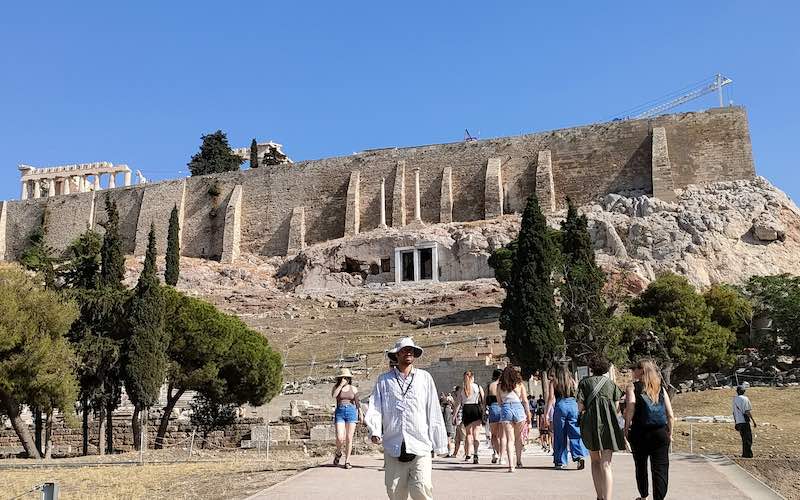Welcome to Athens, the timeless city that stands as a testament to ancient civilisation and is home to one of the most iconic landmarks in the world: the Acropolis. Nestled on the top of a rocky hill, overlooking a bustling modern metropolis, the Acropolis is a breathtaking sight that transports you back in time to the glory of ancient Greece. This is a place that I’ve wanted to visit for a long time, and this year I made that dream a reality. It wasn’t a solo trip, but a trip with my husband to celebrate our 5th wedding anniversary, and what a treat! You see, Athens is perfect for couples, solo, friends and family travel. If you are a fan of the Ancient Greeks and the classical period, then you will be amazed. Today’s blog brings to you my top tips on visiting the Acropolis.
Templeseeker is a participant in the Amazon Services LLC Associates Program, an affiliate advertising program designed to provide a means for us to earn fees by linking to Amazon.com and affiliated sites. Other affiliate links may be used in this article on visiting the Acropolis, but they do not impact on the price that you pay and they do help me to get this information to you for free. Read my privacy policy for more information regarding affiliates.
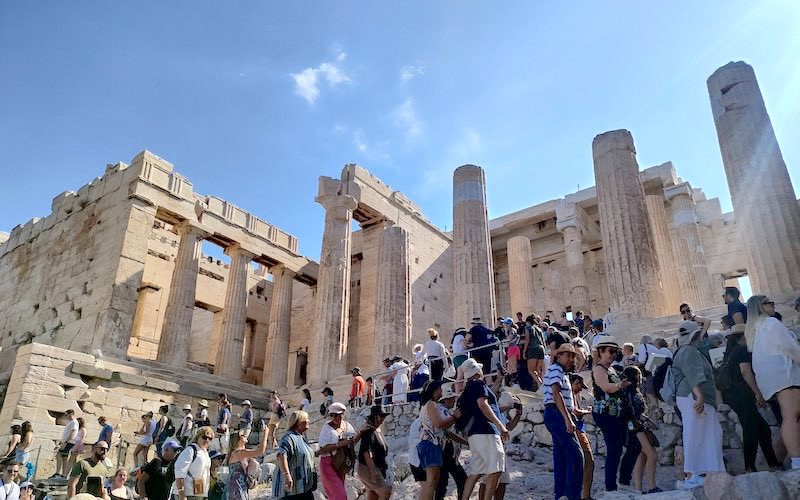
The photographs on my blog are my original copyrighted photography – please do not use these without permission or linking back to www.templeseeker.com as the source. Much of the historical information on the ancient Greek temples is taken directly from the historical information boards at the Acropolis and the Acropolis museum.
Visiting the Acropolis – What does Acropolis actually mean?
The term “acropolis” is derived from the Greek words “akron” meaning “highest point” and “polis” meaning “city.” In ancient Greece, an acropolis referred to the fortified hilltop or elevated area within a city-state where important religious, governmental, and cultural buildings were located. So there is not one, but many ‘Acropolis’ as they were a popular concept in ancient Greece. However, when people talk about ‘The Acropolis’ they are usually referring to the one in Athens.
Is the Acropolis worth Visiting?
The Acropolis is definitely worth visiting and it’s a destination that I believe everyone should see once in a lifetime at least. The ancient theatres (the theatre of Dionysus and Theatre of Herodes Atticus) and temples (Parthenon and Erechtheion) that are found here are truly phenomenal. I would recommend doing it when you are relatively young, fit and healthy as it’s a bit of a climb and on rocky ground. You will also need a pair of decent walking boots like these….
Accessibility and the Acropolis – Disabled Lift
People with mobility issues may struggle to climb the Acropolis. There is actually a lift to take disabled people up the there – if you need to use this contact the beforehand and also bring a doctors note or disabled badge as proof of your disability.
When to visit the Acropolis in Athens
I went to the Acropolis in Easter (very early in the day as well) and it was already intensely hot. It wouldn’t surprise me if people got heatstroke when visiting. I would not dare to venture up the Acropolis from May to September due to the intensity of the heat. The best time to visit the Acropolis is from October to April and on a weekday. Avoid both UK and Greek school holidays. Always go very first thing in the morning, do not attempt to climb the Acropolis during the heat of the day (12-3pm).
Visiting the Acropolis – Top Tips
Here are my top tips for visiting the Acropolis in Athens….
- Wear suncream and a sun hat and take plenty of water – it gets very hot up there as it is the highest point in Athens.
- If you are travelling by Metro, get the metro to Monastiraki which is the best stop for the Acropolis and other ancient Greek sites.
- You will then have a 20 minute uphill walk so be sure to wear sturdy walking boots (I love my lightweight Karrimor ones).
- You need to get there EARLY and I am talking as early as possible (around 8am) to avoid the crowds and the heat of the day.
- When you buy your ticket, go to the main ticket office (this is NOT at the gate but a little building further away from the entrance that usually has no queues).
- Buy the COMBINED ticket for just €30 (price at time of writing in June 2023 – prices can vary with summer or winter season). This will allow you to see all of the ancient sites of Athens over the space of 5 consecutive days from the date you buy it.
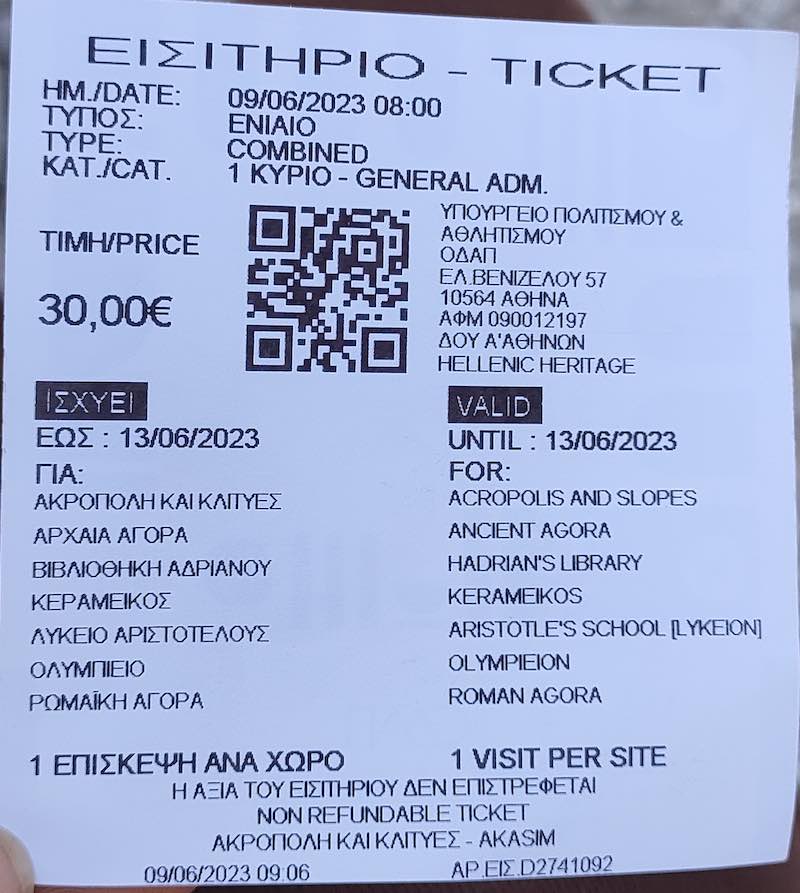
- Once you have bought your ticket, DO NOT ENTER at the main entrance. Instead, walk around the acropolis to the other side (right from the main entrance – basically continue walking) until you get to the second entrance on the side by the museum. It is less busy, less stressful and easier to get in.
- The second entrance is also a better route to take as you ascend the Acropolis passing the two amazing theatres – the Theatre of Dionysis and the Theatre of Herodus Atticus. You can pace your ascent while you appreciate these ancient masterpieces.
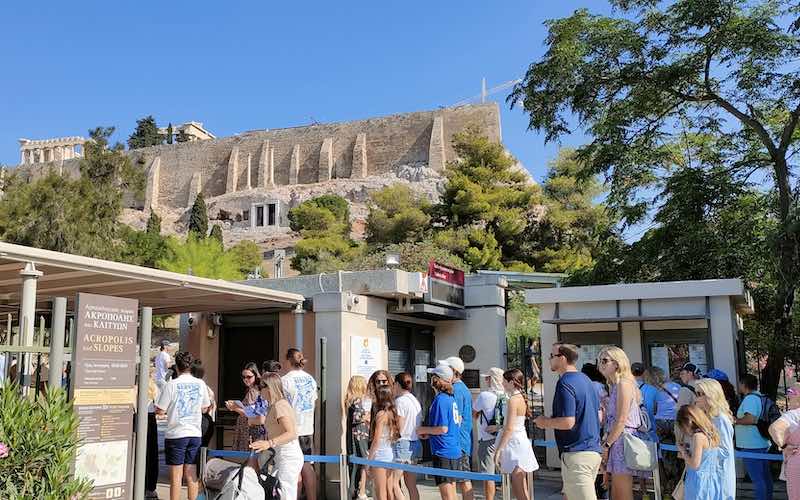
- Keep your ticket safe as you will need to scan the QR code at each site.
- You don’t need a guided tour for the acropolis, I recommend doing it yourself because there are plenty of signs to explain the history of each monument.
- Then follow your Acropolis visit with a visit to the Acropolis Museum to embed your learning and see some of the statues and friezes that were taken from the Acropolis temples for safe keeping.
- The Acropolis closes at sunset so it’s not possible to visit at night, but on the evening you should take yourself to a good viewpoint (such as the temple of Haphaestus in the Agora which is open until 8pm) to see the Acropolis temples all lit up – it is quite spectacular.
- If you are looking for a paperback to read about Athens and the Acropolis then I recommend the Lonely Planet Pocket Athens (Travel Guide) – it’s always nice to have it to hand and to have a physical copy to read at night.
- If you have just one day in Athens for visiting the Acropolis due to a connecting flight, then there are plenty of left luggage stations around the city. We used the one on Monasteraki (Athens Luggage) because we had a late flight and wanted to visiting the Acropolis Museum on our last day in Athens.
The 3 Orders of Ancient Greek Architecture
In order to understand the history and architectural styles when you are visiting the Acropolis temples, you will need a bit of a background in ancient Greek architecture. Once you know the differences between the three main orders of ancient Greek architectural styles you can recognise the differences quite easily. The three main orders of ancient Greek architecture are Doric (plain and square top section of columns), Ionic (swirling top section of columns) and Corinthian (elaborately decorated top section of columns). It is believed that the Doric order is the oldest. Here is a simple summary of each:
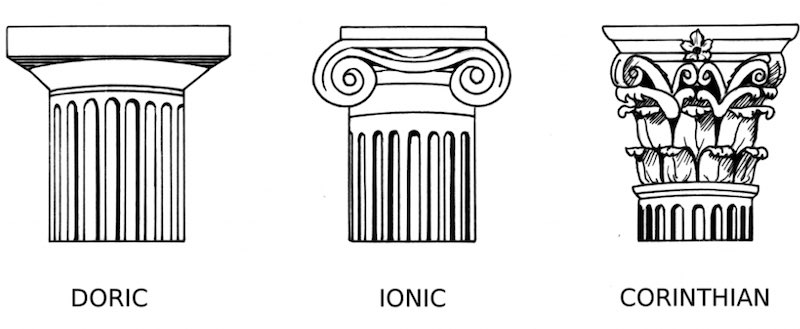
Doric – Dating back to the beginning of the 7th century BCE, this order had the simplest design of columns and was potentially the biggest order of the three (example – the Parthenon).
Ionic – Characterised by the scroll-like swirling ornaments at the top of columns, known as volutes (example – The Temple of Artemis at Ephesus).
Corinthian – Unlike the Doric and Ionic orders, the Corinthian Order doesn’t have its origin in wooden architecture. It grew directly out of the Ionic Order in the mid-5th century BCE and is recognisable by it’s elaborate decoration at the top of the columns (example – temple of Zeus).
Full guide to visiting the Acropolis and Slopes
The acropolis and slopes is a tough walk, but well worth it! This route reflects my recommendation to enter at the second less busy entrance round by the museum. There are a lot of ancient theatres, temples and buildings on the Acropolis and the slopes of the Acropolis.
Main Sites of the Acropolis at a Glance
As well as the main buildings that you expect, there are also a number of additional sanctuaries and remains, including the remains of ancient houses and bathhouses. Make sure that you allow plenty of time at the Acropolis (a minimum of 3 hours at least) as it includes the Parthenon, one of the world’s most famous landmarks. These is a list of the main sites on the Acropolis that you should not miss…
- Theatre of Dionysis
- Odeon of Herodes Atticus
- Propylaea and temple of Athena Nike
- Parthenon
- Erechtheion
- Sanctuary of Zeus Polieus
Theatre of Dionysos
Dionysus Theatre, was an ancient Greek theater located at the foot of the Acropolis in Athens. It was dedicated to Dionysus, the Greek god of wine, fertility, and theatre. The theatre is considered the birthplace of Greek drama and was a central hub for theatrical performances and festivals in ancient Athens. The Theatre of Dionysus underwent several transformations throughout its history. The earliest form of the theatre dates back to the 6th century BCE, which is likely to have begun with wooden benches.
The theatre reached its peak during the 5th century BCE, often referred to as the “Golden Age of Athens.” It was during this period that prominent playwrights like Aeschylus, Sophocles, and Euripides showcased their tragedies and comedies in the Theatre of Dionysus. These plays had philosophical themes such as the human condition and Greek mythology.
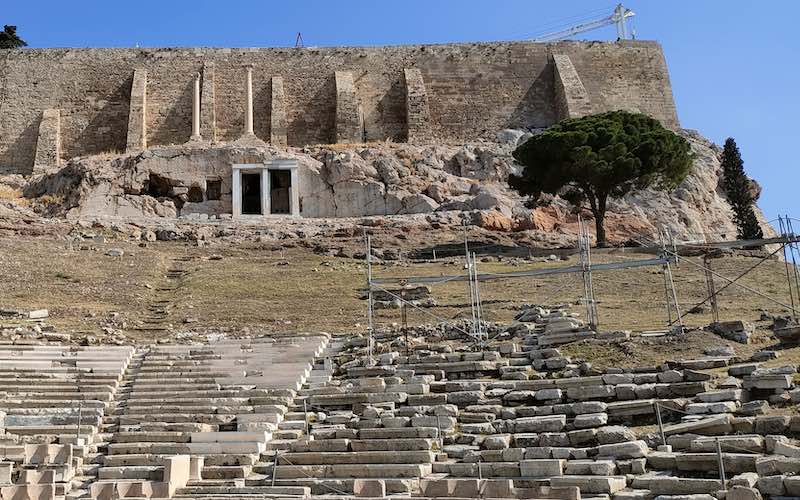
The retaining walls of the parodoi (passages) of the Theatre of Dionysos are one of the characteristic elements of the stone construction of the theatre, which was built, fully in stone, during the archonship of Lycurgos (336-324 BC). These retaining walls mark the main entrance to Dionysus’ theatre and connects the theatre with one of the main roads of the city, the famous Street of the Tripods. It was marked at first by a wooden Doric gate, that was replaced by a new monumental marble Propylon, constructed in the lonic order (architecture that can usually be recogised by swirling scrolls at the top of the colums), in the period of the roman emperor Augustus (27 BC-14 AD).
The major destruction of the Theatre of Dionysos was caused by the raiding groups of Heruli, in 267 AD. In the 6th century AD with the establishment of Christianity a one-aisled basilica was constructed in the main entrance, while the orchestra was transformed into the courtyard of the church.
Odeon of Herodes Atticus
The walk continues up the Acropolis, but before you start the steep ascent to the propylaea (main entrance to the acropolis itself), there is another spectacular theatre – the Odeon of Herodes Atticus. It was built by the wealthy Athenian Herodes Atticus in memory of his wife Regilla and completed around 161 CE. The semi-circular orchestra (stage area) was used for musical performances and recitations. The stage building behind it, known as the scaenae frons, was three stories high and adorned with marble and elaborate decorations. Over the years the odeon eroded and became abandoned, but the restoration of the odeon in 1950 meant that it can now once again be used for cultural events.
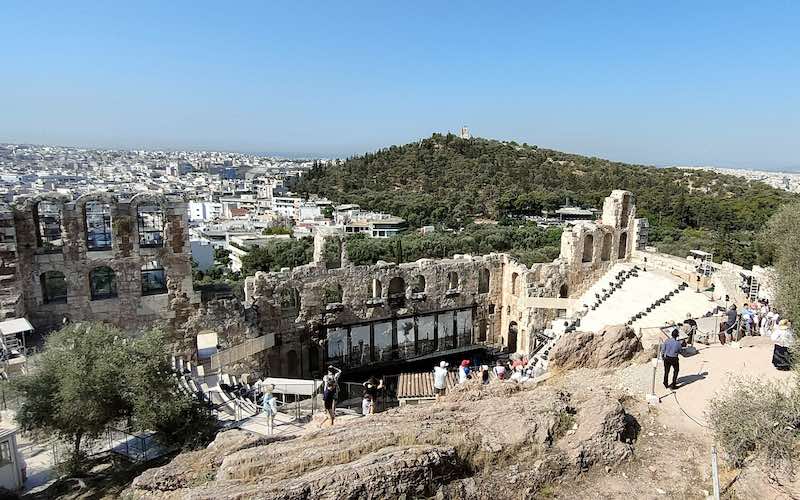
The Propylaea and Temple of Athena Nike
The Propylara is the impressive entrance to the Acropolis, which has a number of uneven slopes and steps leading up to it. This part can get very busy and so take your time and don’t push or shove (this is dangerous). The Propylaea has a temple or shrine to Athena Hygeia and Hygeia was built attached to it and the temple of Athena Nike near to it (Nike was the goddess of victory in Greek Mthology).
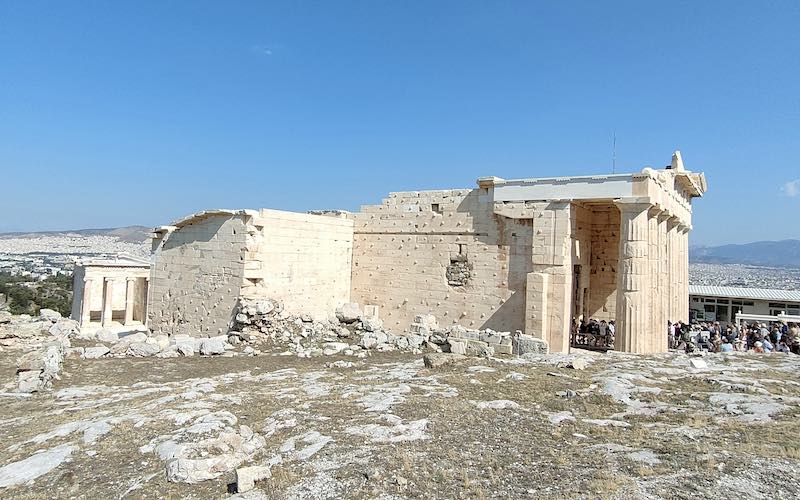
The monumental entrance to the acropolis built at the west edge of the hill in the frame of the building program of Pericles. The construction of the Propylaea was interrupted by the outbreak of the Peloponnesian war, and as a result, the original plan remained incomplete. The central building of the Propylaea was a hexastyle (built with six columns). A cross wall with five doorways divides the central building into two parts. The longer western one is divided into three Royals by two iconic colonnades, each of three columns, which supports the ceiling. The marble ceilings comprised of beams and covered slabs which originally would have had painted decoration. The central building is flanked on the south and the north by two wings with a similar price style Doric porch. In the north wing the hall lying behind the porch might of served as a banquet room and a hall for all the worshippers. The South Wing consists only of a porch through which the sanctuary of Athena Nike was accessed.
In the 6th century A.D. the same thing of the Propylaea was transformed into a single royal Christian basilica. In Medieval times, the Propylaea was converted to a palace by the Frankish and Florentine rulers. During the Ottoman period, in 1640, it was struck by either lightening or a cannonball which caused extensive damage.
Southeast to the central building of the proper layer is situated a small shrine dedicated to both Athena Hygeia (health) and Hygeia, the daughter of Asclepios, who was the God of medicine. The cult of Athena Hygeia dates back to 6th Century BC and the cult of Hygeia is dated back to around 420 B.C.
The Parthenon
Probably the most famous of all Greek ancient sites, the Parthenon is the biggest of the Greek temples and the most notable Athens landmark. This temple of the Doric order, was dedicated to Athena Parthenos (Virgin).
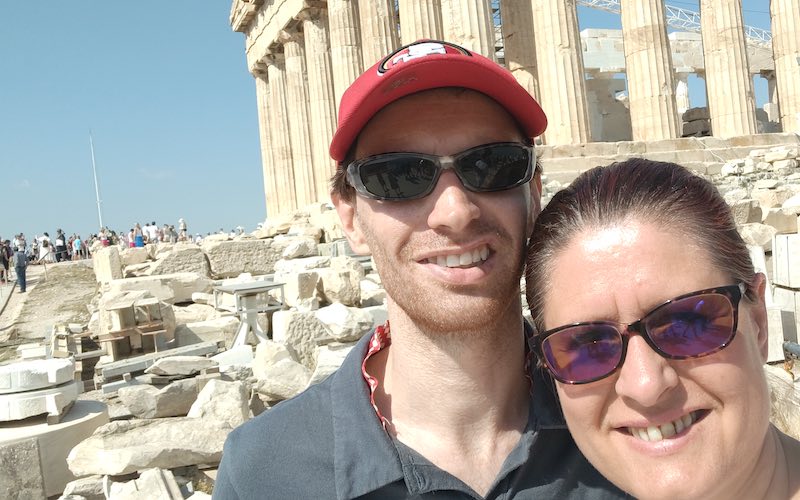
The Propylaea was the most important building of the programme of Perikles for the re-establishment of the Acropolis sanctuary after the sack by the Persians in 480 B.C. The architects of the temple were Iktinos and Kallikrates. The renowned sculptor Pheidias collaborated with other sculptors to design and execute the abundant sculptural decoration of the temple, created the chryselephantine (gold and ivory) statue of Athena which stood in the cella, and had the general supervision of the construction of the temple. The Parthenon was built in 447-438 B.C. and its sculptural compositions were completed in 432 B.C.
In the following centuries, several votive offerings were added to the Parthenon, among which most characteristic were the bronze shields which Alexander the Great dedicated from the spoils of his victory at the Granikos river (334 B.C.). The shields hung along the east architrave, as indicated by the large rectangular holes. The bronze letters of a decree by the Athenians in honour of the Roman emperor Nero (61 A.D.) were fastened in the smaller closely grouped holes on the east architrave.
In the late 3rd or late 4th cent. A.D., the interior of the temple was destroyed by fire either by the Germanic tribe of the Heruli (267 A.D.) or by Alaric’s Visigoths (396 A.D.). During the early Christian period (6th cent. A.D.), the Parthenon was converted into a church dedicated to the “Holy Wisdom” and in the 11th cent. A.D. to Panagia Athiniotissa (Virgin Mary). During the construction of the Christian apse at the east porch (pronaos), the central scene of the east pediment with the birth of Athena was lost. In 1204, the Frankish crusaders, the dukes De la Roche, besieged Athens and converted the monument into a Catholic church of Notre Dame. When Athens was surrendered to the Ottoman Turks in 1458, the temple became a mosque with a minaret. In 1687, during the siege of the Acropolis by the troops of Venetian general Francesco Morosini, a cannonball made a direct hit in the interior of the temple, which the Turks used as a powder magazine. The terrible explosion blew up the roof and destroyed the long sides of the temple as well as parts of its sculptures.
The most severe damage to the monument was caused in 1801-1802, when the Scotch ambassador of England to Constantinople Thomas Bruce, 7th Earl of Elgin, removed the greatest part of the sculptures that also comprised structural members of the temple. By bribing the Turkish garrison of the Acropolis and employing teams of the Italian artist G.B. Lusieri, Elgin removed and transported to England 19 pedimental sculptures, 15 metopes and the reliefs of 56 sawn blocks of the frieze, today exhibited in the British Museum in London. Many other parts of the frieze sculptures around the roof of the Parthenon are preserved today in the Acropolis museum on the top floor, so don’t miss this while you are visiting Athens.
The Erechtheion
This elegant building of the ionic order comes from the name Erechtheus, the mythical King of Athens. The construction started before the outbreak of the Peloponnesian war (431 B.C) or after the conclusion of the piece of Nicholas (401 B.C) the temple was finished in 406 B.C after the work was interrupted by the war.
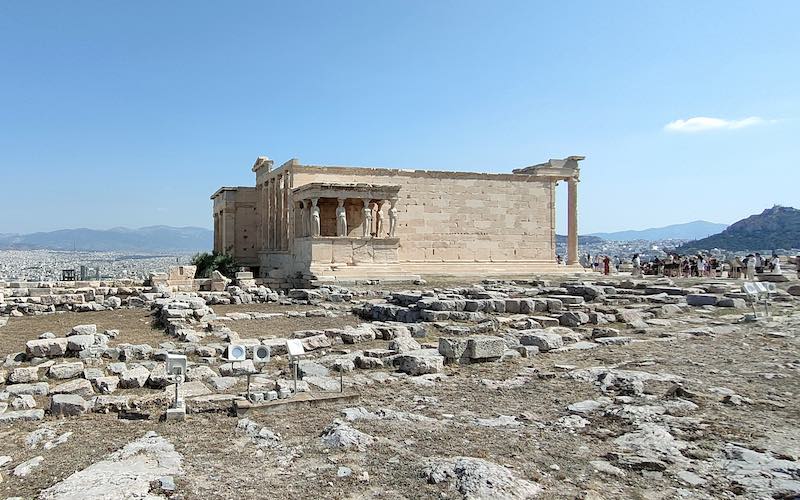
The peculiar plan of the building is due to the natural irregularity of the ground and the need to have the ancient sacred spots: the salt spring (which appeared when Poseidon struck the rock with his trident during the contest with Athens over the patronage of the city), the Trident marks and the tomb of the Athenian Kings Kecrops and Erechtheus.
The Erechtheion consists of a rectangular cellar divided by an interior wall forming two sections. The eastern section, which was at a level of at least 3 m higher than that of the western, was dedicated to Athena Polius and housed an ancient wooden court statue of a goddess. The western section was divided into three parts and dedicated to the court of Poseidon-Erechtheus. Hephaistus and the hero Boutes.
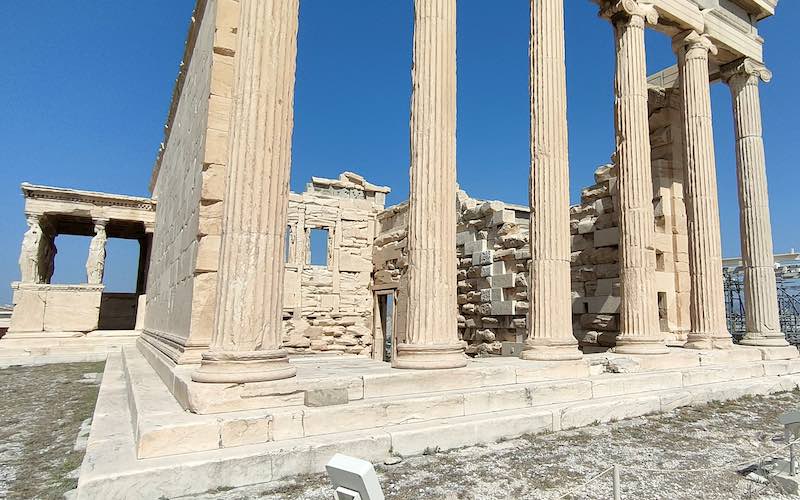
At the north side of the cellar there is a magnificent porch with six ionic columns. The bases and capitals along with the frame of the doorway leading to the interior of the cellar have elaborate relief decoration while the ceiling covers were painted. The famous porch of the maidens or Caryatids dominates the south side of the building. These six statues of young women standing on a podium 1.77 m high support the roof of the porch, which was part of the Kecrops tomb above the ground. The Caryatids (young maidens) that you see today are replicas as the originals are in the Acropolis Museum.
At the upper part of the building is a frieze of grey Eleusinian stone to which relief figures of white Parian marble were attached. Today these are also exhibited in the Acropolis museum.
Around the end of the first century BC the rich Theon was repaired after a fire. During the Christian period it was transformed into Church, while in the Ottoman period it was used as a house. In the first years of the 19th century, Lord Elgin carried off the third Caryatids from the west and the column of the Northeast corner of the building (as mentioned previously, the current Caryatids are copies).
The Erechtheion is a beautiful temple with a stunning backdrop – don’t miss it!
Sanctuary of Zeus Polias
You can also see the remains of the temple of Zeus Polias. “Polias” refers to Athena Polias, the patron goddess of Athens, to whom the temple was dedicated. It was one of the earliest major temples constructed on the Acropolis, dating back to the 6th century BCE.
Other Ancient Sites in Athens
If you have the combined ticket, you can visit all of these ancient sites also: Ancient Agora, Roman Agora, Kerameikos, Hadrians library and Olympeion (temple of Zeus) and Aristotles school (The Lykeion). I would strongly recommend that you DO NOT attempt to do these on the same day as the acropolis (it will be way too much and you will be knackered!) Spread these out over your second and third day in Athens.
- Ancient Agora – This was the central marketplace of ancient Athens. It is also home to another famous Greek temple of Hephaestus which is one of the best preserved ancient Greek temples in Athens. Hephaestus was my favourite – you can still see some of the friezes and even the roof is still intact.
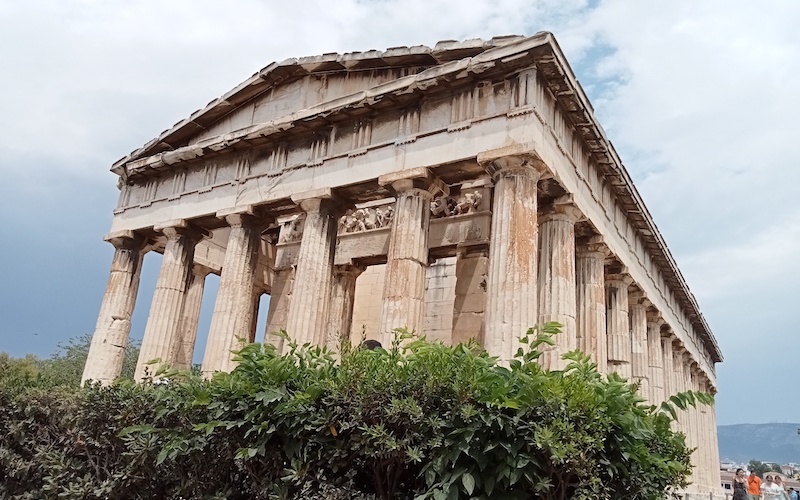
- Hadrians Library – An ancient Roman building that served as a library and cultural complex during the reign of Emperor Hadrian in the 2nd century AD.
- Kerameikos – Kerameikos archaeological site and cemetery has great historical and cultural significance as one of the city’s major burial grounds and as an area associated with craftsmanship and pottery production.
- Aristotles School (Lykeion) – An ancient educational institution in Athens, Greece. It was founded by the philosopher Aristotle in the 4th century BC and served as a centre for philosophical and scientific studies
- Olympieion – This is often called the Temple of Zeus. An ancient temple stands as a testament to the grandeur and ambition of ancient Greek architecture and was dedicated to Zeus (king of the gods in Greek mythology). Be aware that recently it had scaffolding around it to try to preserve the ancient pillars of the temple.
- Roman Agora – The Roman Agora was a public square and marketplace located in Athens, Greece. It was constructed during the Roman period, around the 1st century BC, and served as a hub of commercial, social, and political activity.
Remember to have your ticket ready to be scanned on the gate, and you can only have one visit per ticket, you cannot re-enter the sites multiple times.
List of what to pack for visiting the Acropolis
- Comfortable walking trousers – lightweight and cropped walking trousers are perfect for visiting the Acropolis.
- Euros and a credit or debit card (for buying your ticket).
- T-shirt or lightweight and comfortable top (linen or cotton) – I like these short sleeved gym T-shirts and wear them all the time when travelling.
- Sturdy walking boots (not flip-flops, sandals or trainers) – I wear Karrimor weatherlite walking boots for women.
- Sun hat or cap (you will need to keep the sun off your head as it’s intense).
- Refillable water bottle or a backpack with several bottles of spring water – I like my lifestraw as it has an inbuilt filter. SIGG bottles are also really great because they are so strong and sturdy.
- A good smartphone, camera and gimbal (if you intend to take videos) – I love my DJI OSMO.
- Battery pack (such as this Anker Powerbank) and charging cable for phones (you do not want to run out of battery and not be able to get pictures of the Acropolis).
- Small and comfortable daypack (large backpacks are not allowed) – this Deuter Gogo Daypack is ideal.
- A good paperback guide book such as the Lonely Planet Pocket Athens.
- A lanyard with clear pouch is good if you want to have your ticket to hand for the other ancient sites in Athens (Roman Agora, Hadrians library etc) but I kept my ticket in my phone case which worked well.
The Acropolis – Overall Verdict
Overall, the Acropolis of Athens is not to be missed – it’s one of the most spectacular ancient sites in the world. If you have further questions on visiting the Acropolis, please do not hesitate to comment on my blog and I will do my best to answer you!
Further reading on Athens and Greece
Here are some other blogs that you might find useful when you plan your trip to Athens for visiting the Acropolis….
- Is Greece worth Visiting?
- Is Athens worth visiting?
- Things to do in Nea Makri
- One day in Athens itinerary

